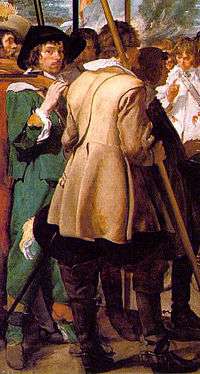The Surrender of Breda
|
Spanish: La rendición de Breda, Las lanzas | |
 | |
| Artist | Diego Velázquez |
|---|---|
| Year | 1634–5 |
| Type | Oil on canvas |
| Dimensions | 307 cm × 367 cm (121 in × 144 in) |
| Location | Museo del Prado, Madrid, Spain |
La rendición de Breda (English: The Surrender of Breda, also known as El cuadro de las lanzas or Las lanzas) is a painting by the Spanish Golden Age painter Diego Velázquez. It was completed during the years 1634–35, inspired by Velázquez's visit to Italy with Ambrogio Spinola, the Genoese general who conquered Breda on June 5, 1625. It is considered one of Velázquez's best works. Jan Morris has called it "one of the most Spanish of all pictures".[1]
History
The capture of Breda in 1625 was one of the few major successes of Spanish arms in the latter stages of the Eighty Years' War. The Spanish general, Genoese aristocrat Ambrogio Spinola, conquered Breda against the instructions of his superiors. Before its capture, the Spanish government had decided that siege warfare against heavily defended towns of the Low Countries was too wasteful and that they would concentrate instead on an economic blockade of the Dutch republic. The bulk of Spanish forces were diverted to the unfolding Thirty Years War.
Breda, a city near the frontier of Holland proper had been occupied in 1567 by the Duke of Alba, ten years afterwards recovered by Holach, and again seized by Haultepenne. The town was the seat of the Orange family, who had a castle there.
In 1624, the suspension of hostilities in Germany enabled the Spanish to concentrate their forces towards Breda. Although attacking such a formidable fortress was widely considered to be unwise, Ambrogio Spinola made the bewildering executive decision to march on Breda, accompanied by the Marquis de Leganés and Carlos Coloma. Spinola had made a military reputation for himself in 1604 and been rewarded with the Golden Fleece for conquering Ostend in Flanders. Consequently, the siege of Breda was not only a clash between the Netherlands and Spain, but a “decisive contest between two famous generals, [Spinola and Dutch general Nassau], both well versed in the arts of fortification, who had their renown at stake”.
Defending the Dutch, Maurice of Nassau led hostilities against Spinola but died before the end of the siege. His successor, Frederick Henry, unsuccessfully attempted to revive Dutch momentum, but ultimately surrendered in May. The terms of defeat at Breda were some of the most honorable and lenient of the time. Spinola died in the autumn of 1630, only a year after Velazquez had sailed with him on the voyage to Italy. In 1637 Breda was recaptured by Frederick Henry after a four-month siege, and in 1648 it was finally ceded to the Dutch Republic by the Treaty of Westphalia.
Velázquez painted The Surrender of Breda as an emblem of Spanish nationalism and as a tribute to Ambrogio Spinola. Diego Velázquez and Ambrogio Spinola had been thrown closely together “During the voyage from Barcelona to Genoa, in 1629… The artist must also have been more deeply affected than others by the tragic result of the siege of Casale, which occurred soon after the voyage – how Spinola was shamefully sacrificed; and how, mortified at the slur cast on his military honor, he soon after sank with gloomy thoughts into the grave.”
Velázquez felt discouraged after Ambrogio Spinola’s death and sought to legitimize Spinola, whose success and bravery in the battle inspired Velázquez to paint The Surrender of Breda.
Description

The Surrender of Breda was one of twelve life-size battle scenes intended to perpetuate victories won by Philip IV’s armies that hung in the Salón de Reinos in Buen Retiro. It illustrates the exchange of keys that occurred three days after the capitulation between Spain and the Netherlands was signed on June 5, 1625. Hence, the focus of the painting is not on the battle itself, but rather the reconciliation. At the center of the painting, literally and figuratively, is the key given to Spinola by Justin of Nassau. The key is “the precise center of his design, [enclosing] it in an emphatic parallelogram so that it becomes the focus of the entire large canvas—literally the key to the composition, locking all other components into place.” This battle painting is notable for its static and sentimental qualities.
According to the statement made by eye-witnesses both [Spinola and Nassau] had dismounted and Spinola awaited the arrival of Justin surrounded by a “crown” of princes and officers of high birth. The governor then presented himself with his family, kinsfolk and distinguished students of the military academy, who had been shut up in the place during the siege. Spinola greeted and embraced his vanquished opponent with a kindly expression and still more kindly words, in which praised the courage and endurance of the protracted defense.
The extraordinary respect and dignity Spinola demonstrated towards the Dutch army is praised through The Surrender of Breda. Spinola “had forbidden his troops to jeer at, or otherwise abuse, the vanquished Dutch, and, according to a contemporary report, he himself saluted Justin.” The painting demonstrates the glimpses of humanity that can be exposed as a result of war, and commends Spinola’s consideration for Nassau and the Dutch army.
Velázquez’s relationship with Spinola makes The Surrender of Breda especially historically accurate. The depiction of Spinola is undoubtedly accurate, and Spinola’s memory of the battle contributed to the perspective with which Velázquez composed the painting. Velázquez’s knowledge of the intimate history of the siege of Breda makes The Surrender of Breda an especially important historical commentary. Velázquez “desired in his modest way to raise a monument to one of the most humane captains of the day, by giving permanence to his true figure in a manner of which he alone had the secret.” The Surrender of Breda salutes a moment of convergence between Spanish power, restraint, and kindness in the battle.
References
- ↑ James Morris, Spain, 1964, p. 29.
Sources
- Justi, Carl. Diego Velázquez and his Times. London: H. Grevel & Co., 1889.
- López-Rey, José. Velázquez’ Work and World. Greenwich, CT: New York Graphic Society, 1968.
- Morris, James. Spain. London: Faber & Faber, 1964.
- Museo Nacional del Prado, "The Surrender of Breda, or The Lances" (accessed July 3, 2009).
- Pioch, Nicolas. "Velázquez (or Velásquez), Diego." October 14, 2002. http://www.ibiblio.org/wm/paint/auth/velazquez/ (accessed December 4, 2008).
- White, John Manchip. Diego Velazquez: Painter and Courtier. Chicago: Rand McNally & Company, 1969.
External links
- Velázquez , exhibition catalog from The Metropolitan Museum of Art (fully available online as PDF), which contains material on The Surrender of Breda (see index)
| Wikimedia Commons has media related to La rendición de Breda. |
